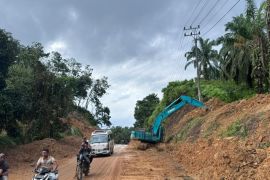"The flower is still blossoming perfectly since Saturday (Jan 6), and the view is breathtaking," Riki Septian, the coordinator of Bengkulu Utara Care for Rare Blooms Community (KPPL) said.
After the ranger found the blooming flower, local tourists have packed the conservation zone since Saturday.
Most of the tourists were seen taking pictures with the rare Rafflesia gadutensis, which has been dubbed as the largest flower in the world.
Septian said, for the tourists who want to see the Rafflesia flower, they have to be assisted by the rangers during the trekking, and viewing activities.
The rangers, he explained, need to guide the tourists, because the flower which was found near the Palak Siring Kemumu waterfall is situated within the conservation area.
Therefore, the ranger needs to ensure any visits made by the local would cause no harm to the flower and its habitat, Septian remarked.
"All visitors should be guided by the rangers, in order to ensure that the flower`s young buds would continue to flourish normally," he stressed.
In order to see the rare blooming "corpse" flower, people need to take five-minutes trekking, by following the concrete stairs in the conservation forest.
After stepping the stairs, the visitors need to take the left side, in order to see the protected flower.
"People are still able to enjoy seeing the rare blooming flower for the next three days," he noted.
Apart from Rafflesia gadutensis, the Boven Lais conservation forest is a home for other Rafflesia species, such as Rafflesia arnoldii and Rafflesia kemumu, the new endemic bloom found in Bengkulu.
First discovered by W. Meijer in Ulu Gadut, West Sumatra in 1984, the Rafflesia gadutensis is distinct to other species, because of its special "white-dots" pattern and the smaller petal size for only 40-60 centimeter in diameter, while the average Rafflesia would extend to some 100 cm in diameter.
As a jungle parasite, the Rafflesia flower has no trunks, roots, or leaves.
Apart from its gigantic size, the bloom also gains popularity worldwide due to its strong "corpse" odor.
Reported by Helti Marini Sipayung
(Uu. KR-GNT/a014)
Reporter: antara
Editor: Heru Purwanto
Copyright © ANTARA 2018











